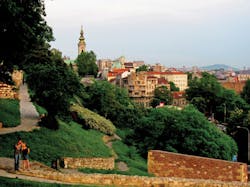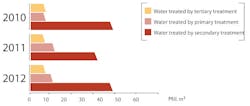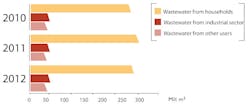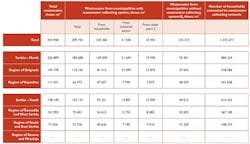Intergrated water approach for Serbia's Resurgence
Lacking investment and regulation over the years has meant Serbia's water infrastructure has been neglected. In the central part of the country only 37% of the population are connected to a mains sewerage system. Change is at hand, however, with a new adopted regulation on the emission limit values in surface and ground waters.
by Svetlana Vujovic´ and Srd-an Kolakovic´
The Republic of Serbia, which covers 88,361 km2, is located in the south-eastern part of Europe, at the heart of the Balkan Peninsula. The country can be divided into three broad zones on the basis of geography and climate, land quality, farming systems, socio-economic development, and political and administrative boundaries. These include the regions of Vojvodina, Central Serbia and Southern Serbia.
Approximately only 8% of all available surface waters in Serbia originate within its borders. The remaining 92% are transboundary waters entering Serbia through the Danube, Sava, Tisa, Drina and other rivers.
Compared to the EU countries, Serbia has a poor reputation concerning wastewater management. Serbia, as many transition and developing countries, has been facing many challenges to restructure its wastewater management system into a sustainable one.
Two Public Water Management Companies (PWMC) - Srbijavode; Vode Vojvodine - have been formed to manage water within the certain administrative regions.
Surface water quality
Surface water quality in Serbia is not at a satisfactory level. The examples of very clean water - class I and I / II - are very rare and are found in mountainous areas, for example along the river Djetinja, Rzav, Studenica, Moravica, Mlava in Central Serbia.
Utilized capacity of existing groundwater sources for water supply, according to the Water Master Plan of Serbia, is about 23 m3/s, or about on third of available resources. From this, about 45% is used by the population, about 25% is for industry and public consumption, with the remaining water consumed during the process of purification of the water and losses in the network. Irreversible losses in the water supply are estimated at about 20% of abstracted water.
The average specific water consumption per capita in Serbia is about 350 l/day of raw water for drinking purposes, sourced from groundwater (59%), surface water (24%) and springs (17%). Approximately half of the country's population lives in urban areas and is supplied by the three largest (Belgrade, Novi Sad and Niš) or medium-sized water supply systems.
In the Autonomous Province of Vojvodina there are 465 settlements of which 69 do not have piped water. People living in rural areas get their drinking water from three different sources: i) official piped water systems owned and operated by the municipality; ii) private piped systems built and operated by the communities themselves, and iii) private wells (tube well/borehole with pump, dug well.
Data on rural public water supply systems are very scarce, but it is estimated that there are about 5,000 that are not registered and are not water quality controlled.
Water supply systems cover 300,000 private wells. Only 10% of the exploited water sources are protected with sanitary protection zones around intakes.
Wastewater in Serbia
In most European cities the percentage of households connected to the sewerage system varies around 95% while in Belgrade this number reaches only 85%. At the national level these indicators show an even worse situation. For example in the Province of Vojvodina the same indicator is around 45%, while in central Serbia it goes even lower with around 37% of the population is connected to the sewerage system.
The results of an analysis performed within the project 'Global Waste Water Study in Serbia & Pre-feasibility Study for Belgrade Waste Water Management' show that about 75% of the total urban population in Serbia is connected to the public sewerage system.
The percentage of the rural population connected the public sewerage system is about 9%. Only three urban municipalities have a rate higher of 75% - Kragujevac, Novi Sad and Sremski Karlovci.
Agglomerations with a population smaller then 25,000 are usually equipped with the general sewerage system while municipalities with 25,000 to 250,000 citizens have a separate stormwater system. The city of Novi Sad has only one sewerage system.
Abandoned WWTPs
A survey shows that there are 19 municipalities in Serbia, with wastewater treatment plants, 14 with biological treatment and five with mechanical treatment.
Concerning the rest of Serbia, only seven local municipalities have already started to build such a plant (six with biological treatment) while 11 municipalities reported that they are planning the construction in the near future.
Only 16% of the population in Serbia is connected to the wastewater treatment plant. The largest cities in Serbia, including Belgrade, Niš and Novi Sad release their wastewater untreated into the passing rivers.
Some of the existing wastewater treatment plants are abandoned, many only provide primary (mechanical) treatment and many are not continually operated, due to poor maintenance and lack of financial resources.
Pollution prevention
Serbia has contributed to the practical implementation of the Water Framework Directive, as an active participant in the International Commission for the Protection of the Danube River.
On the positive side, new regulations present the basis for a new, "combined approach" in water pollution prevention. During the period 2010-2012, numerous by-laws were adopted, including a regulation on the emission limit values in surface and ground waters and associated deadlines to reach these achievements.
For the first time, the regulator of Serbia has issued all limit values for process wastewaters (by sectors) at the facility/unit discharge location, with the demands for separating wastewater flows and prohibiting the dilution of these waters in order to achieve the above-mentioned values.
Svetlana Vujovic´ and Srd-an Kolakovic´ are from the Faculty of Technical Sciences at the University of Novi Sad, Serbia.
For more information on the article, email: [email protected] or [email protected]
Serbian Environmental Protection AgencY (SEPA)
The country's environmental regulator, SEPA, has made the following assessment of Serbia's water infrastructure:
- Collection and treatment of wastewater is the least developed segment of the water;
- Low percentage of polluters with wastewater treatment plants (WWTPs);
- Low percentage of existing Comunal WWTPs which are operational;
- Insufficiently developed public sewerage systems (50% of the population connected);
- Unbilled water/distribution and network losses exceed acceptable levels. n There needs to be prioritized construction of WWTPs for all communities larger than 2000 P.E.;





